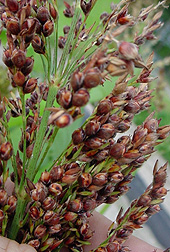This page has been archived and is being provided for reference purposes only. The page is no longer being updated, and therefore, links on the page may be invalid.
| Read the magazine story to find out more. |
|
|
Sorghum Eyed as a Southern Bioenergy Crop
By Jan SuszkiwSeptember 17, 2012
Sweet sorghum is primarily grown in the United States as a source of sugar for syrup and molasses. But the sturdy grass has other attributes that could make it uniquely suited to production as a bioenergy crop, U.S. Department of Agriculture (USDA) studies suggest.
Sorghum is an ideal candidate because of its drought tolerance, adaptability to diverse growing conditions, low nitrogen fertilizer requirements, and high biomass (plant material) content, according to molecular biologist Scott Sattler and collaborator Jeff Pedersen with USDA's Agricultural Research Service (ARS). It also produces soluble sugar that can be converted to biofuel. Residual fibers left over from the juice extraction process also can be burned to generate electricity.
Sattler and Pedersen's studies of sorghum are part of a larger effort by ARS-USDA's principal intramural scientific research agency-to answer a government mandate calling for the production of up to 36 billion gallons of biofuel by 2022. Approximately 15 billion gallons of that total will come from grain ethanol, with the remaining 21 billion gallons to come from other sources, or "feedstocks," including sorghum, sugarcane, other grasses like switchgrass, and oilseed crops like rapeseed and soybean.
Sorghum and sugarcane are top candidates for production in the southeastern United States because they are complementary crops that can extend the biofuel production season and utilize the same equipment, note Sattler and Pedersen, who work at the ARS Grain, Forage and Bioenergy Research Unit in Lincoln, Neb. However, they are not the only team examining sweet sorghum's energy potential.
At the ARS Crop Genetics and Breeding Research Unit in Tifton, Ga., geneticist William Anderson and his colleagues are working to identify desirable sweet sorghum genes and their functions so improved varieties can be developed. In studies, they selected 117 genotypes from the ARS sorghum germplasm collection at Griffin, Ga., and evaluated them for their ability to mature quickly and resist fall armyworms and the fungal disease anthracnose.
Read more about this and other bioenergy research in the September 2012 issue of Agricultural Research magazine.

